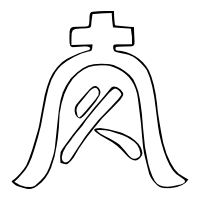Recreational research into Feudal Japan
Posts tagged Ōsaka
Mon of the Week: Bell
Aug 24th (a Sembu (先負))
Today we look at another mon from the same collection of provincial samurai mon from the 15th century.(KJ:7) Today’s mon uses an enclosure that didn’t become a common element in Japanese mon despite its simplicity and elegance.
The enclosing shape appears to be a bell. Bells were associated with Buddhist temples, which used large bells to announce times for prayers, meals, and other such scheduled events in much the same way as Western churches and monasteries. These bells are struck from the outside by thick hanging wooden poles, instead of having an internal ringer and moving the bell itself with ropes.Watch movie online John Wick: Chapter 2 (2017)
The character inside is slightly mysterious despite being clearly drawn. It’s most probably a variation on 久, meaning ‘long time’, which in addition to being used in the Japanese equivalent of “long time no see” (久しぶり/hisashiburi) also has auspicious connotations of longevity.
While cross-like elements like the one present here would later be common in the mon of “secret Christians” (Kakure Kirishitan) after Christianity was outlawed in Japan, this particular mon predates such things. Here it perhaps represents a ring hanging the bell from a beam.
Similar bells would also be used as fire bells in the Edo period,(ja.wp:半鐘) when the population density and wooden construction in Edo caused frequent fires. In the peace of the Edo period, some warriors turned to serving in fire brigades summoned by such bells. More realistic, three-dimensional depictions of these bells are used in mon today.(Dower:105)
As a side note, a supposed veiled insult engraved on a temple bell is supposed to have triggered the Ōsaka Campaign,(en.wp:Bell_(instrument)) which is one good source of depictions of military mon.
Mon of the Week: Natagama
Jul 4th (a Sembu (先負))
Here we have an interesting mon. Unlike many of the mon we’ve discussed recently, this mon has died out, and is no longer in use. In fact, finding information about this mon at all is quite challenging! It was used by Ōno Harufusa in the Battle of Ōsaka.(SH:62) What do you think it is?
My initial source for this mon, Stephen Turnbull’s Samurai Heraldry, describes this mon as a ‘hatchet’. But it doesn’t look like any hatchet I’ve ever seen. Perhaps this was some sort of traditional Japanese hatchet? Looking into it, however, it seems that Japanese hatchets are pretty similar to Western ones. What then?
After an extensive search, I found the mon in a Japanese collection of Sengoku period mon. Here it is identified as a “nata” (鉈).(SSS) This turns out to be a traditional forestry knife similar to a small machete used by woodcutters and for wilderness survival.(ja.wp:鉈) (The same kanji can also be used to mean “hatchet” in compounds, and a nata can be used for splitting wood like a hatchet, to give Turnbull some credit.) What this mon most resembles, however, is not the ordinary nata, but a variation called a “natagama” (鉈鎌) or “billhook”, which, unlike the plain nata, includes the hook at the end. It is mainly suited for cutting brush and branches, but could also be used as a weapon.(en.wp:Billhook)
As to why this mon didn’t catch on? One possibility is that, straddling the line between a weapon and a tool, once mon representing tools became associated with lower classes it was seen as not suitable for a samurai. Of course, the fact that our friend Harufusa seems not to have had any children(ja.wp:大野治房) may also have something to do with it.


